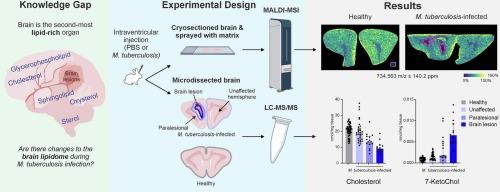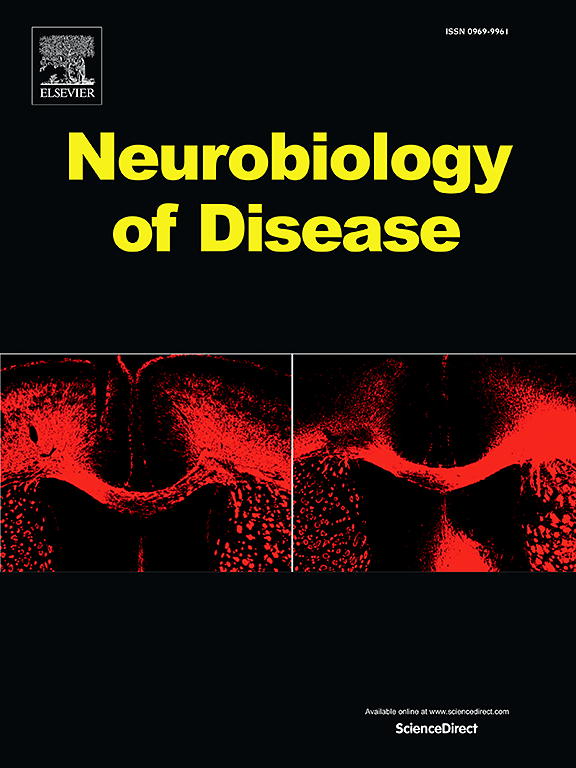结核性脑膜炎的空间异质性脂质失调
IF 5.1
2区 医学
Q1 NEUROSCIENCES
引用次数: 0
摘要
结核(TB)性脑膜炎是肺外结核病中最致命的一种,儿童和免疫力低下的人受其影响尤为严重。对肺结核的研究表明,结核分枝杆菌可以改变宿主的脂质代谢,从而躲避免疫系统。降低胆固醇的药物(即他汀类药物)可降低感染风险,因此成为肺结核宿主导向疗法的希望所在。然而,结核杆菌感染对青少年或成年人脑脂质组的影响尚未得到研究。大脑是仅次于脂肪组织的第二大脂质丰富器官,其脂质组在时间和空间上具有异质性,从婴儿期到成年期都会发生变化。由于胆固醇代谢紊乱可导致发育障碍,进而导致智力残疾,因此发育中的儿童大脑可能特别容易受到脂质组成和稳态改变的影响。为了开始了解小儿结核性脑膜炎脑脂质组的改变,我们利用以前发表的结核性脑膜炎幼兔模型,并应用质谱(MS)技术来阐明空间差异。我们使用了基质辅助激光解吸/电离-质谱成像(MALDI-MSI),并辅以区域特异性液相色谱(LC)-MS/MS,以识别和量化 MALDI MSI 难以识别的甾醇和氧基甾醇。MALDI-MSI 发现了在脑损伤中下调的几种鞘脂类、甘油脂类和甘油磷脂类。LC-MS/MS 显示,结核杆菌感染直接导致胆固醇、胆固醇生物合成途径中的几种固醇中间体和酶促产生的氧基甾醇含量下降。然而,氧化应激产生的氧基甾醇在脑损伤中有所增加。总之,这些结果表明,在小儿结核性脑膜炎中,脑脂质组存在明显的空间调控失调。本文章由计算机程序翻译,如有差异,请以英文原文为准。

Spatially heterogeneous lipid dysregulation in tuberculous meningitis
Tuberculous (TB) meningitis is the deadliest form of extrapulmonary TB which disproportionately affects children and immunocompromised individuals. Studies in pulmonary TB have shown that Mycobacterium tuberculosis can alter host lipid metabolism to evade the immune system. Cholesterol lowering drugs (i.e., statins) reduce the risk of infection, making them a promising host-directed therapy in pulmonary TB. However, the effect of M. tuberculosis infection on the young or adult brain lipidome has not been studied. The brain is the second-most lipid-rich organ, after adipose tissue, with a temporally and spatially heterogeneous lipidome that changes from infancy to adulthood. The young, developing brain in children may be uniquely vulnerable to alterations in lipid composition and homeostasis, as perturbations in cholesterol metabolism can cause developmental disorders leading to intellectual disabilities. To begin to understand the alterations to the brain lipidome in pediatric TB meningitis, we utilized our previously published young rabbit model of TB meningitis and applied mass spectrometry (MS) techniques to elucidate spatial differences. We used matrix assisted laser desorption/ionization-MS imaging (MALDI-MSI) and complemented it with region-specific liquid chromatography (LC)-MS/MS developed to identify and quantify sterols and oxysterols difficult to identify by MALDI-MSI. MALDI-MSI revealed several sphingolipids, glycerolipids and glycerophospholipids that were downregulated in brain lesions. LC-MS/MS revealed the downregulation of cholesterol, several sterol intermediates along the cholesterol biosynthesis pathway and enzymatically produced oxysterols as a direct result of M. tuberculosis infection. However, oxysterols produced by oxidative stress were increased in brain lesions. Together, these results demonstrate significant spatially regulated brain lipidome dysregulation in pediatric TB meningitis.
求助全文
通过发布文献求助,成功后即可免费获取论文全文。
去求助
来源期刊

Neurobiology of Disease
医学-神经科学
CiteScore
11.20
自引率
3.30%
发文量
270
审稿时长
76 days
期刊介绍:
Neurobiology of Disease is a major international journal at the interface between basic and clinical neuroscience. The journal provides a forum for the publication of top quality research papers on: molecular and cellular definitions of disease mechanisms, the neural systems and underpinning behavioral disorders, the genetics of inherited neurological and psychiatric diseases, nervous system aging, and findings relevant to the development of new therapies.
 求助内容:
求助内容: 应助结果提醒方式:
应助结果提醒方式:


